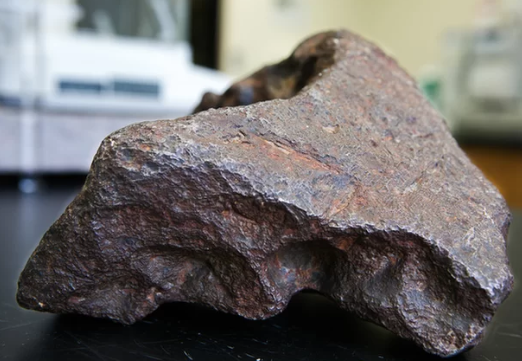Ripley Entertainment Inc.'s Blog, page 313
October 12, 2018
Virginia Town Threatens Trick-Or-Treating Teens With Jail Time
Featured in Ripley's Believe It or Not!

[October 7-13th, 2018] A door-stop that’s out of this world, some very pudgy bears, and jail-time for trick-or-treating teens.
Expensive Door-Stop
For 30 years, a 22-pound rock of unknown origins propped open a Michigan man’s door. Asking not to be named, he finally took the rock to a geologist to get it checked out. Mona Sirbescu, a geology professor at Central Michigan University, identified it as a meteorite worth $100,000—turning out to be the sixth-largest space rock found in Michigan!

Central Michigan University
Fat Bear Week
Every year, Katmain National Park holds a tournament between its bears to see which can get the fattest. Dubbed “Fat Bear Week” the animals go through a March Madness-style bracket to see who has bulked up the most for hibernation. Gorging on salmon until their bodies are almost sphere-shaped, the park offers before and after photos to highlight the dramatic transformation. This year’s winner was bear 409, Beadnose.

Katmai National Park
Yellowstone Vomits Up Trash
While Yellowstone is famous for the reliable eruption of the Old Faithful geyser, many of the volcanic waterspouts in the park erupt years apart. The Ear Spring geyser just had its biggest eruption in 60 years, and it barfed up a lot of trash. Park Rangers found cement blocks, cans, and even a pacifier from the 1930s launched from the geyser. They’ll be putting many of the items in their archives, but also reminding visitors to not throw trash into the geysers.

Robot Answers Hearing Summons
The UK Parliament has called its first robot witness to give testimony. Softbank Robotics’ Pepper is a semi-humanoid bot equipped with artificial intelligence technology, and will be asked to answer Parliament members relating to technology.

Mike Dotta/Shutterstock
Trick-or-Treating The Law
Believe it or not, in Chesapeake, Virginia, trick-or-treating over the age of 13 could face up to six months in jail. The city notes that it will have officers on the streets of Halloween, but that they haven’t been instructed to specifically check people’s ages. Beyond the age limit, the town’s 48-year-old law also has a strict curfew on trick-or-treating, issuing misdemeanors for anyone engaging in Halloween fun after 8:00 pm.

Source: Virginia Town Threatens Trick-Or-Treating Teens With Jail Time
CARTOON 10-12-2018
October 11, 2018
Cream Artist Uses Lattes As His Canvas
Featured in Ripley's Believe It or Not!

Lee Kang-bin of Seoul, South Korea, has become Instagram famous for his latte art inspired by movies, TV shows, books, and pop culture.
The 26-year-old barista creates all of his artwork freehand on top of the frothy milk of lattes. He uses just a thin metal rod and food dye to carefully color the foam, weaving cute characters and portraying popular icons.
View this post on Instagram
A post shared by 이강빈 (@leekangbin91) on Jul 8, 2017 at 7:01pm PDT
He’s created milky replicas of such masterpieces as Vincent van Gogh’s Starry Night, and Edvard Munch’s The Scream—the soft frothiness of the foam lending itself well to their impressionist styles. Utilizing the contrast between bright dyes and the pure-white milk, he’s also able to bring colorful scenes from Disney movies to life.
A coffee at Kang-bin’s shop costs 10,000 won—about nine dollars—and takes him just 15 minutes to complete. The artist has to work fast, in order to ensure the coffee is still hot enough by the time the customer drinks it.
Practicing for over a decade, Kang-bin has become a celebrity in the latte art world, judging competitions and even taking on young barista pupils. His craft is entirely self-taught. He began serving coffee when he was 17. At the time he was enrolled in South Korea’s compulsory military training. He bought a coffee machine and began service to help his fellow soldiers out.
View this post on Instagram
A post shared by 이강빈 (@leekangbin91) on Oct 4, 2018 at 3:16am PDT

From conga-dancing dogs and bicycling ballerinas, to hair-raising feats of strength and death-defying motorcycle stunts, Ripley’s Believe It or Not! A Century of Strange! is sure to delight readers of all ages. With over 1,200 weird-but-true stories from around the world and 256 pages of wild and wonderful photography, this year’s collection of all things odd is not-to-be-missed.
QUIZ: Which A Century of Strange Personality Are You?
In love with Lee Kang-bin’s cream art? Find out which friendly (or freaky!) face from Ripley’s Believe It or Not! A Century of Strange you are! Take this quiz to find out!
Don’t miss out on being an ODDthority on everything strange, get your copy on Amazon today!
Debunking the Image of the Ninja
Featured in Ripley's Believe It or Not!

Or Not
In today’s world many misconceptions have been perpetuated—becoming modern day “facts”—when, in reality, myths and hearsay have taken over. Sorry to burst your bubble, but in this weekly column, Ripley’s puts those delusions to the test, turning your world upside down, because you can’t always…Believe It!
Today: The truth about ninjas.
What does the word “ninja” conjure up? Nimble guys and gals dressed in black with only their assassin-trained eyes showing? Samurai swords and throwing stars comprising the deadly arsenal they carried?
While Hollywood has done an excellent job of filling our heads with the iconic image of ebony-clad, sword-wielding ninjas, this couldn’t be further from the truth. Here’s why everything we know about ninja is wrong.
What Do Farmers and Ninja Have in Common? A Lot!
Ninja needed to blend in with the masses, which meant not looking like ninja. The function and mission of each ninja proved different, not unlike contemporary CIA agents. They needed to appear inconspicuous and move about the countryside freely, without raising alarm.
Ninja dressed and chose weapons according to their missions. In fact, one of the greatest weapons a ninja employed was blending in. Your average ninja probably looked a lot more like a farmer with a kusari-gama (sickle with chain attachment) than anything out of a King Fu movie.
Why? Because ninja strongholds predominated in rural areas. Of course, some also dressed as workers, merchants, and monks, depending on where they needed to fit in—economically, socially, and geographically. But the essential point remained “fitting in.”
To this day, the word “ninja” in Japan stirs up connotations of “spies” and “espionage,” and with good reason. The dual missions of most ninja included gaining information and spreading disinformation. Like modern spies, few ninja acted as trained assassins.
The Truth About Ninja Weapons
Alright, prepare for some more bubble bursting. Ninja didn’t carry samurai swords because, to put it bluntly, they weren’t samurai. Doing so meant something akin to impersonating a cop today. And back then, such an act earned the death penalty. Ouch! Yes, those who came from regions with a sword-carrying tradition may have carried swords of other types. But, again, no standardized outfit or set of weaponry screamed “ninja.”
Ninja didn’t throw around shuriken (throwing stars) like they were going out of style either. Remember that whole thing about blending in? That’s kinda hard to do when you’re lobbing sharp metal stars at the general public. What’s more, no written records contemporaneous to the ninja exist describing how shuriken were used in warfare. Or, how they were used at all for that matter.

Were shuriken thrown? Or, used to threaten people at star point? Were they used for slashing? The verdict’s still out on this one.
The bottom line remains. No specific “ninja toolkits” or “ninja wardrobes” ever existed. What’s more, ninja didn’t rely on outdated, antiquated weaponry. They proved far more interested in flintlocks than nunchaku. Turns out, these secret agents (not unlike today’s CIA) experimented with the latest weaponry.
According to Matt Alt and Hiroko Yoda, authors of Ninja Attack!: True Tales of Assassins, Samurai, and Outlaws, “Ninja were at the cutting edge of weapons technology of their day, experimenting with explosives and diversions and flintlock rifles and anything that would give them an edge. Believe me, a 16th-century ninja would have been overjoyed with a pair of night-vision goggles or a modern assault rifle or a stealth drone. They just didn’t exist back then, so the ninja had to make do with what they had.”
But What About Those Black Pajamas?
For those special occasions when ninja actually did need to skulk around at night, they wore dark blue rather than black. Why? Because the night sky appears indigo, not black. Dressing in all black would have outlined them against the night sky according to the Ninja Museum of Igaryu. Sticking out like a sore thumb represented a clear no-no in feudal Japanese espionage.
So, where did all of these ninja myths come from? Like cowboys and pirates, mythmaking swirls around the historical figure of the ninja. In fact, the word “ninja” didn’t even enter the Japanese lexicon until the 19th century.
From the birth of the word, it remained inextricably linked to the legendary and supernatural. But as 19th-century writers and storytellers struggled to place the fantastical character of the ninja in realistic story settings, they had to get creative.
For example, how would they explain the mythic “invisibility of ninja” in their modern stories? By borrowing from Japanese theater. During plays, the kuruko (theatrical stagehands) wore all black costumes, thus appearing “invisible” while changing the scenery. Why not adopt the same costume for ninja? Apparently, none of these writers gave the actual color of the night sky a second thought.

An 1817 print of a storybook ninja.
As the West grew more and more fascinated by these legendary Japanese figures, the details adapted by writers to fill gaps in the storyline got cemented into the iconic image of the ninja. Not unlike our modern (faulty) associations with the Western cowboy.
What Happened to the Ninja?
Ninja proved so good at fitting in that they literally disappeared into the general populace. Despite their best efforts at concealment, though, they sparked a powerful myth that captures the popular imagination to this day.
What’s more, anybody involved in information exchange, disinformation, and espionage continues to follow the path forged by ninja so long ago. And like the first ninja, today’s spies leave the black pajamas in the bedroom!
But don’t worry. You can still wear your iconic ninja costumes for Halloween. Like cowboys, pirates, and Santa’s elves, the symbol proves even more legendary than the historical reality.
By Engrid Barnett, contributor for Ripleys.com
Source: Debunking the Image of the Ninja
San Jose’s Giant-Sized Monopoly Board
Featured in Ripley's Believe It or Not!

In San Jose, you actually can use a Get Out of Jail Free card.
And you can collect $200 when you pass Go.
And you can simultaneously own Park Place and Broadway.
But you can only do all of this if you’re lucky enough to be playing the bigger-than-lifesized Monopoly board game in San Jose’s Discovery Meadow, near the city’s Children’s Discovery Museum. The board game is the largest permanent version of Monopoly in the world, and it’s sure to cause more than its fair share of family rivalries and arguments.

CC Anna Fox/Flickr
Originally built on a lark in 1992 as part of the San Francisco Landscape and Design Show, the granite board covers more than 900 square feet of the park. Squares can weigh anywhere between 150-250 pounds, and huge dice round out the fantasy-turned-reality.
To no one’s surprise, the game can — and is frequently — played. Enthusiasts rent time via the board’s website and are given giant dice and hats resembling their choice of the well-known small, silver characters that trot around the board. An announcer helps keep time and score.
The only attraction in San Jose that’s featured in the Guiness Book of World Records, it is not cheap—$300 per match, which apparently pays for the staff to set up and run the game.
OTHER CRAZY HUGE GAMES (and where to play them):
Scrabble

This photo of Mississippi Children’s Museum is courtesy of TripAdvisor
Mississippi Children’s Museum — Jackson, Miss.
Get ready for a triple word score! The Mississippi Children’s Museum in Jackson boasts the Hasbro-official giant Scrabble. It’s a great place to get in touch with your inner dictionary, but be careful, or you’ll find yourself eating your words.
Chess

PhillipR/Shutterstock
World Chess Hall of Fame — St. Louis, Mo.
In St. Louis they say the summer equals outdoor chess. In the Central West End on Maryland Avenue, everyone can go play outside the Chess Club and Scholastic Center of St. Louis. Or you can pop in to the World Chess Hall of Fame to check out its exhibitions and artifacts. Make sure to get your picture taken with the World’s Largest Chess Piece.
Mousetrap
Various sites — check lifesizemousetrap.org/home
If you’ve ever been amazed by the hundreds of moving parts that is the Mousetrap game, just wait until you see Mark Perez’ Life Size Mousetrap. Combining Newtonian physics with large-scale art, the performance has created a unique brand of engineering fun in a traveling road show. Just like the regular-sized game, it’s science made cool!
By Ryan Clark, contributor for Ripleys.com
CARTOON 10-11-2018
October 10, 2018
The Mysterious And Beautiful Lake Filled With Millions Of Jellyfish
Featured in Ripley's Believe It or Not!

In the sparsely populated country of Palau sits a small island named Eil Mul. Barely peaking above the high tide of the ocean, this island holds a secret.

Just a few hundred feet from the beach lies a marine lake that is home to millions of jellyfish. The jellies in the lake have lived there for 12,000 years. Isolated from the open ocean, they have evolved their own biology and routine. Sea and rainwater enter the lake through a shallow complex of coral caverns left over from a time before humans walked the Earth. Though water can flow in through these narrow fissures and crevices, the jellyfish themselves cannot leave.

This long-time isolation has caused the moon and golden jellies in the lake to mutate slightly. Golden jellyfish are genetically close to their widespread brethren in nearby lagoons but have many unique characteristics. The golden jellies are missing spots and have shortened arms. To derive sustenance, they rely on a symbiotic relationship with algae living in their tissue.

A golden jellyfish (left) compared to a spotted jellyfish (right).
Scientists are still trying to decode the cryptic secrets of the lake’s moon jellyfish DNA, but are fairly certain that the species has not interbred with other moon jellies in millions of years.
Both of the lake’s inhabitants have lost much of their stinging tendrils, rendering them harmless to divers. This has made the magical lake full of gentle jellyfish a bucket-list location for divers all over the world.
The jellyfish make a series of daily migrations across the lake’s surface, following the Sun during the day and even the Moon at nights. Despite their large numbers, they swim only near the surface of the water, where food and oxygen are available. The bottom of Jellyfish Lake is a toxic trap. Below where the reef allows in fresh water, the atmosphere is dead. Oxygen-less and tainted with hydrogen sulfide, a journey to the lake bottom would mean death for a jellyfish and would even be toxic for a human diver.
The jellyfish are instead content to live in their isolated lake, close to the surface where the environment is precariously balanced to support life. Warming climate conditions have often proven disastrous for Jellyfish Lake, with the population cratering during strong El Niño. Despite threats from ocean warming, the population has demonstrated an ability to bounce back in a short period of time. After almost no jellyfish were observed in the lake in 1998, they seemed to make a full comeback by 2012.
Source: The Mysterious And Beautiful Lake Filled With Millions Of Jellyfish
CARTOON 10-10-2018
October 9, 2018
Fossilized Oosik: Ancient Walrus Penile Bone
Featured in Ripley's Believe It or Not!

Sitting in the icy wastes of the Arctic for tens of thousands of years, a mysterious object is found by an Inuit hunter. The strange item is long and hard. It doesn’t melt like an icicle and has considerable weight. The hunter polishes the strange object into a weapon, a blunt club which he uses to silence struggling seals he needs for food an warmth. The object is an oosik, and it was once the penile bone of a walrus.

Penile bones are found in many mammals in the animal kingdom. Known as a baculum, the rigid structure is found within the male reproductive organs of many primates, rodents, bats, dogs, bears, seals, and walruses. Scientists aren’t certain what purpose the baculum serves, but hypothesize that the bone allows some males to mate more competitively by enabling them to copulate for long periods at a time.
Flippered marine animals have lived in the Arctic for over 20 million years, becoming the dominant predatory mammals alongside polar bears and man. Known for their giant bodies weighing up to 5,000 pounds and stretching 16 feet in length, modern walruses remain one of the biggest predators in cold waters. Both male and female walruses have long tusks which they use to fight, dig for food, and cut through sheets of ice. While they have been heavily hunted in more modern times for their tusks, conservation laws have long put a stop to the trade, what has remained, however, is a fascination with their penile bones.

It is true that Inuit hunters have found millennias-old oosiks frozen in ice and turned the fossilized bones into clubs and knife handles. While many people may want to emulate the walrus’s blubbery fury with a tusk, others have decided they see more power in the symbol of a walruses masculinity. Besides weapons, oosiks have been fashioned into jewelry, fertility elixirs, or even plainly displayed as curios trophies.
The largest oosik ever recovered measured four-and-a-half feet long, belonging to a long-extinct walrus of gigantic proportions. Found by Russian fossil hunters combing defrosting permafrost for wooly mammoth remains, the four-foot oosik was so well preserved that bits of skin remained intact. The team first mistook the object’s size and thought it must be a mammoth tusk, but a fossil dealer preparing to clean the oosik luckily realized what it was before damaging the specimen. Dated to be around 10,000 years old, with preserved skin, the rare find was eventually acquired by Ripley’s Believe it or Not! for $8,000. It’s currently on display at the Ripley’s Odditorium in San Francisco.

CARTOON 10-09-2018
Ripley Entertainment Inc.'s Blog
- Ripley Entertainment Inc.'s profile
- 52 followers







